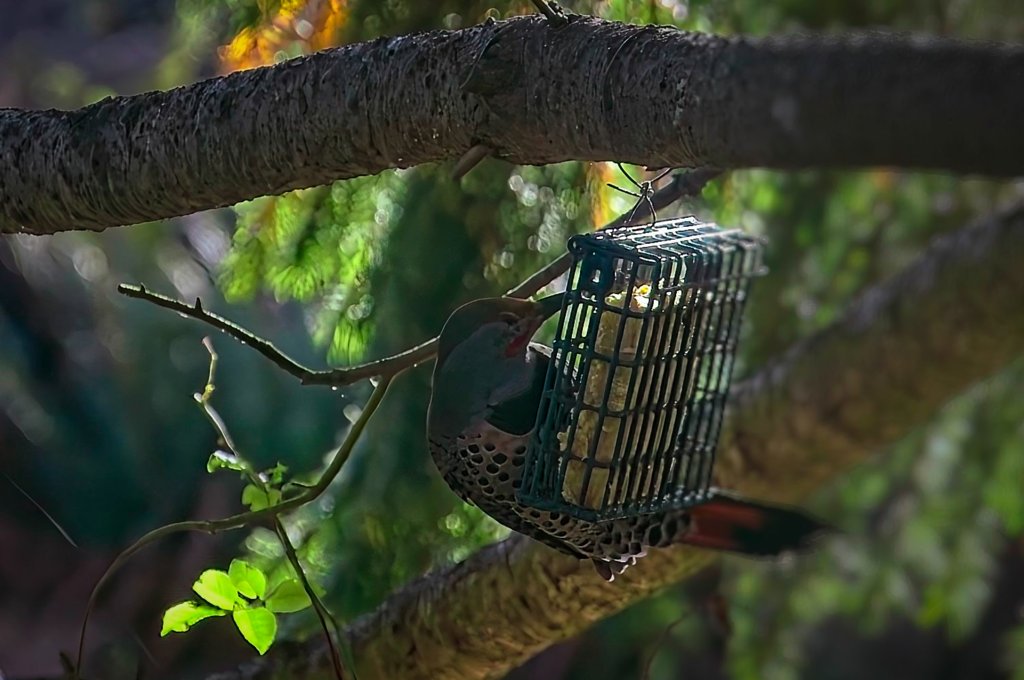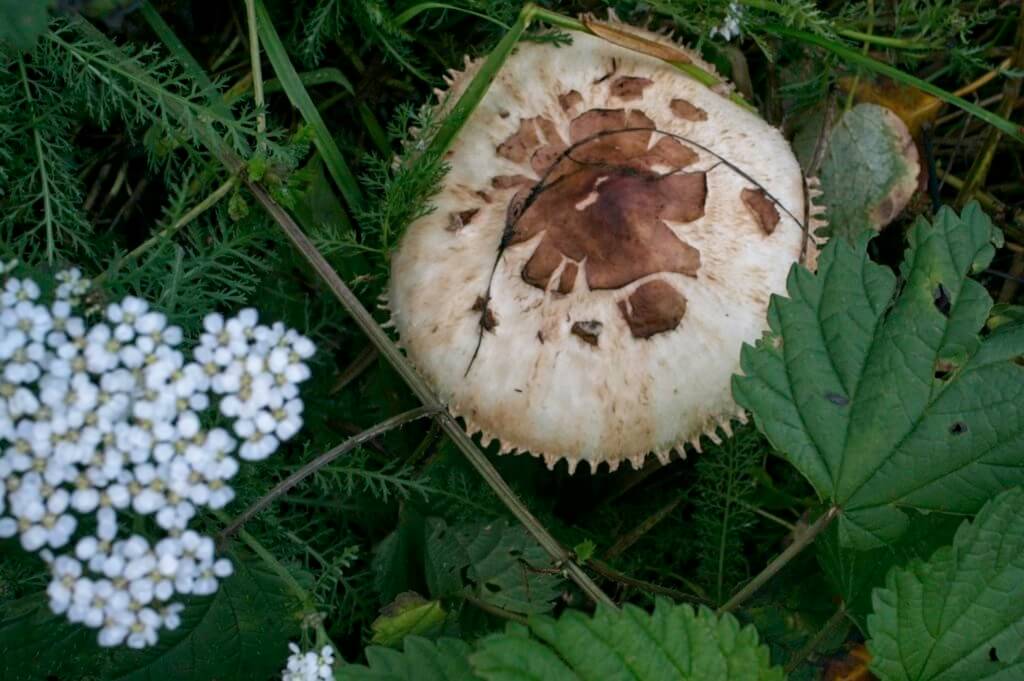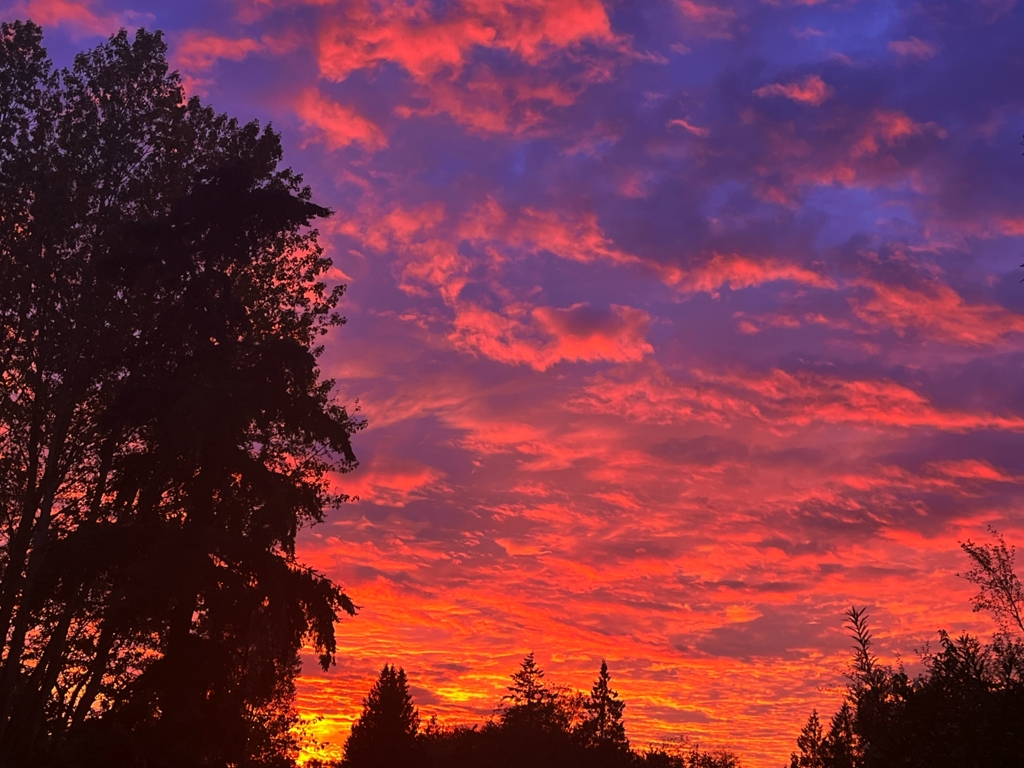And suddenly it is the end of October.
The flush of lime green in spring seemed like only yesterday – and how it darkened into deeper hues, burst with bold flowers and berries, faded into late summer ambers, and now blazes with the reds and oranges of autumn. The colors are warm, but the air is crisp. The birds at the feeder outside my window seem to have a certain urgency about their comings and goings, quite different from that in the spring. I feel it, too.


October –
When the golden hour can last all day
Until it turns to grey.
When the morning fog is so thick, it just might be rain
Caught in a spiderweb net,
Bursting into kaleidoscopes in the morning sun.


October has a certain boldness about it not found at other times of year. It is when we can see things that hid undercover in the heat of summer. Trunks and branches seem almost black against bright yellow leaves, which are becoming sparser by the day, leaving the branches naked, and in their parting, exposing geometric bold angles, twists, and turns.
Small things suddenly stand out — look how the delicate leaves of violets are bright beside the heart leaves of wild ginger! And the big Bay Laurus nobilis … I thought we had lost you to our last brutal winter, but no – you found strength through your deep roots and put forth glossy leaves to declare you are still here!
We duck beneath branches into the thicket; it is easier to walk quietly on dampened leaves. Occasionally we find a filbert that the jaybirds missed. Treasure! Paths once overgrown by bordering shrubs now expose passages through filtered light, revealing portals that we always suspected were there.
This is the time between the packed dry earth of summer and the deep hard freeze of winter. Recent rains have softened the soil, releasing a fragrance of moss and mushrooms and that moldy-earthy smell of decay and life. I give a rope of bindweed a tug and the earth lets go. Arm-length after arm-length of morning glory – is there no end to this? I think – Perhaps I should weave baskets of this? But when would I have time? This is a vine that can completely cover and smother a tree, keeping all the sunlight to itself and thereby preventing the entangled plant from photosynthesizing its own food. It’s like starving them in broad daylight. I know I will never completely get rid of it. But for now, it is easier to set it back, and what I accomplish today will save me a lot of work in the spring. A brisk breeze energizes my efforts. I can almost hear the shrubs take a deep breath and soak up the sun as I untwist and cut the tangled vines from their branches. Perhaps too little too late? My handsome Quince has obviously suffered.
October is a time to get orderly and bring tender plants inside. I have rearranged things in the greenhouse to make room for the wasabi, Andean root collections, and assorted plants in pots that if left to fend for themselves outside, would be lost in the jungle, i.e., several aronia shrubs, some groundcover cuttings, a few potted herbs, and collections of American groundnuts and Chinese yams (which can be difficult to differentiate from morning glory.) Fall is the perfect time to transplant larger plants into the ground where they can spread their roots: a paw paw tree I’ve been pampering indoors for far too long; several currant bushes; some native columbines.
Time to tuck things in. I use a hand scythe to cut back the tall grass around shrubs and arrange cardboard and hay around the perimeter. Perhaps the cardboard is not necessary. Maybe I am only creating winter shelter for voles. It seems the right thing to do, along with leaving leftover plant stalks, piles of twigs and debris, and heaps of leaves for all the caterpillars, spiders, beetles, snakes, and other small creatures too numerable to count. We all need a place to hunker down. We are all keenly aware it won’t be long now. The birds, too, are chittering about it in the willows. My feathered friends have harvested almost all the autumn olives, but I still find a few. There are lots of rosehips this year for everyone to share (and they are huge!).
Perhaps there is still time to go for walks in the woods and seek out chanterelles? I am easily sidetracked. No, not now. I need to keep focused on accomplishing tasks at hand: put away hoses, leftover pots, and anything that will take flight in the wind. There are apples to pick and preserves to can. Leaves to rake and spread around trees and beneath shrubs. Tools to bring inside.
But it is definitely mushroom season. Beneath the seaberries and gooseberries, among the nettles and yarrow, I find several large caps. I am not sure of their identity, so I leave them be. It makes me happy to know that the soil here is full of fruiting fungal mycelium. My work at adding organic matter must be paying off. Success!


Behind the barn, I check on the honey bee hives that we left vacant this last spring for any passing swarms. Two colonies moved in. One seems quite robust; the other not as much. Last winter was rough on the bees, and we lost our homesteaders. This is the time of year when yellowjackets often raid the hives and also when the honey bees tell the drones they must leave. The evicted drones gather together outside the hive, absorbing the warmth of the wood in the low-setting sun. They seem to be discussing what to do next. I feel sad for them, but understand it is their way. Some have already fallen to the ground; the rest won’t make it through the heavy cold rain that is forecast for tonight. Birds or mice will come along later and eat them. The cycle continues.
I am interrupted by the loud honking of geese flying overhead. They seem to arrive in great waves, their voices carrying across the cloudscape. I can hear them when they appear as mere dots in the distance, but then as they get closer, their calls are so loud, one has to stop talking – or at the very least, stop, look up, and listen. The changing V patterns are mesmerizing as they weave in and out. “Come join us!” they call to one another until they number in the hundreds. They overnight in nearby fields of harvested corn, fattening up with the leftover stubble. They will need the energy. It is almost time to leave.
It is nearly 6 pm and already approaching twilight. I used to work outside past 9. I stop in my tracks to watch the transformation in front of me. I have the urge to grab my camera and watercolors before it’s too late, but I am spellbound by the changing colors in the sky and cannot move. I think – The geese must really enjoy this view from high in the sky! It is the perfect ending to the day.

We are amid a great turning. Shifting light, colors, patterns, cycles … all is in flux. Smell the approaching rain! The wind is no longer playful. It has a serious sting to it that makes us reach for hats and scarves. Every day I watch for the first frost. The first snows are already on the nearby Olympic mountains. November gale-force blusters will whisk away remaining leaves in the days to come, but for now, we are immersed in the glow of changing colors and light.
I love this time of year. We transition into November.
But before I go…
Here are a few more photos of flowers I found still blooming into late October! Amazing!
And one last look at the Great Willow Cathedral in full splendor at this time of year!

~ * ~
Still blooming in October at Barbolian Fields
Asters
Beebalm
Boneset
Borage
Calendula
Catnip
Chives
Coreopsis
Cosmos
Costmary
Dahlia
Dandelion
Echinacea
Elecampane
Evening Primrose
Feverfew
Golden Marguerite
Hollyhocks
Joe Pye Weed
Kenaf
Lavender
Marigolds
Mint
Morning Glory
Mullein
Nasturtium
Oregano
Poor Man’s Orchid
Rudbeckia
Rose
Sedums
White Campion
Wild Mustard
Available Fruits
So much abundance! Leaving lots for wildlife. It's the least I can do.
Apples
Autumn Olives
Blackberries (only a few)
Evergreen Huckleberries
Grapes
Highbush Cranberries
Manchurian Viburnums
Maypop Passionfruits (in the greenhouse)
Medlars
Raspberries (a few late ones, because the deer ate down the shrubs so much earlier in the season)
Red Flowering Currants
Rosehips (multiple varieties)
Seeds
Trying to keep things simple and not collect Everything! Leaving lots for wildlife:
Angelica
Artichoke & Cardoon
Borage
Columbine
Coreopsis
Cosmos
Crocosmia
Echinacea
Fennel
Good King Henry
Hollyhock
Joe Pye Weed
Kenaf
Cuttings
Thought I would take a few cuttings of these:
Blueberries
Currants?
Goji
Honeyberries (Haskap)
Kinnikinnick
Lavender
Native Huckleberry
Rosemary
Sage
Thyme
Thank you for reading!
May this find you well. I wish you abundance!
…Blythe












